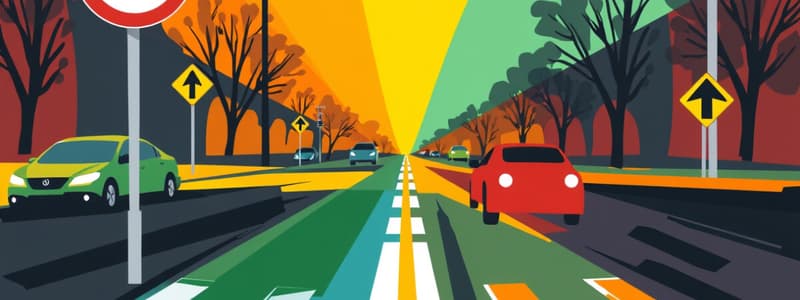Podcast
Questions and Answers
Where is the chance of a collision greatest?
Where is the chance of a collision greatest?
- On a straight road
- In a parking lot
- At an intersection (correct)
- On a highway
You may make lane changes once in an intersection.
You may make lane changes once in an intersection.
False (B)
What is your last check when turning?
What is your last check when turning?
For a controlled zone.
What is an intersection with signals or signs to assign the right of way called?
What is an intersection with signals or signs to assign the right of way called?
What does it mean to yield?
What does it mean to yield?
When are stop or yield signs present on a street?
When are stop or yield signs present on a street?
What enables others to yield the right of way for a left turn?
What enables others to yield the right of way for a left turn?
A light that has just turned green is called a fresh green light.
A light that has just turned green is called a fresh green light.
What does an intersection with a left-turn light or green arrow indicate?
What does an intersection with a left-turn light or green arrow indicate?
Turning right on red after stopping is always permitted.
Turning right on red after stopping is always permitted.
What should you do if your vision is blocked by parked vehicles when crossing an intersection?
What should you do if your vision is blocked by parked vehicles when crossing an intersection?
How is a controlled railroad crossing identified?
How is a controlled railroad crossing identified?
In which areas are uncontrolled intersections generally found?
In which areas are uncontrolled intersections generally found?
What must you do when you identify a pedestrian at an uncontrolled intersection?
What must you do when you identify a pedestrian at an uncontrolled intersection?
What shape is the sign for a railroad crossing?
What shape is the sign for a railroad crossing?
What does an uncontrolled railroad crossing usually have?
What does an uncontrolled railroad crossing usually have?
What should you be prepared for when following a bus across a railroad crossing?
What should you be prepared for when following a bus across a railroad crossing?
You have the right of way at an intersection at all times.
You have the right of way at an intersection at all times.
Traffic signs and signals show who should yield the right of way.
Traffic signs and signals show who should yield the right of way.
You must yield the right of way at traffic signs.
You must yield the right of way at traffic signs.
How large of a gap should you have when crossing a street with traffic moving at 30 mph?
How large of a gap should you have when crossing a street with traffic moving at 30 mph?
How long does it take to turn right and accelerate to 30 mph?
How long does it take to turn right and accelerate to 30 mph?
What must you judge the size of when crossing a through street from a stop sign?
What must you judge the size of when crossing a through street from a stop sign?
When turning right and joining traffic, what happens if the faster traffic is moving?
When turning right and joining traffic, what happens if the faster traffic is moving?
When near an uncontrolled intersection, which way should you look first?
When near an uncontrolled intersection, which way should you look first?
Flashcards are hidden until you start studying
Study Notes
Intersection Safety
- The highest likelihood of a collision occurs at intersections.
- No lane changes are permitted once inside an intersection.
- Final checks while turning should include confirmation of a controlled zone.
Types of Intersections
- Controlled intersections have signals or signs to dictate the right of way.
- Yielding allows others the right of way before proceeding.
Traffic Control and Signals
- A through street is established when stop or yield signs are present at two corners of the intersecting street.
- Left turns are permitted only when the left-turn arrow is green, ensuring right of way granted by other drivers.
Green Lights and Turning
- A light that has just turned green is termed a fresh green light.
- Intersections designated with left-turn lights, green arrows, or delayed green lights are classified as protected left turn zones.
- Right turns on red are generally allowed unless otherwise indicated by posted signs.
Visibility and Awareness
- At intersections where visibility is obstructed by parked vehicles, it is essential to look left, right, and ahead while moving forward cautiously.
Railroad Crossings
- Controlled railroad crossings are marked by flashing red lights and gates, alerting drivers to potential hazards.
- Uncontrolled crossings are usually indicated by a crossbuck sign along with a round yellow sign representing caution.
Right of Way Regulations
- Always cede the right of way to pedestrians in uncontrolled intersections.
- The right of way at an intersection is only yours if other drivers acknowledge and yield to you.
- Traffic signs and signals clearly indicate who must yield the right of way.
Yielding at Signs and Traffic Considerations
- Yield the right of way at all traffic signs and stoplights.
- While crossing streets where traffic is moving at 30 mph, a gap of approximately two-thirds of a block is necessary in each direction.
Timing and Execution of Turns
- It typically takes around 6 seconds to accelerate to 30 mph after making a right turn.
- When turning right and merging with traffic, larger gaps are required when faster traffic is approaching.
Observational Techniques
- Use the left side as a priority gaze while approaching uncontrolled intersections to assess oncoming traffic effectively.
Studying That Suits You
Use AI to generate personalized quizzes and flashcards to suit your learning preferences.




